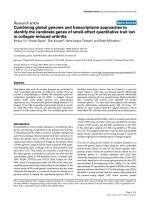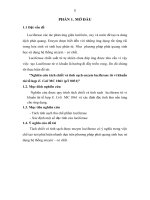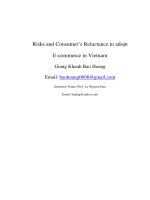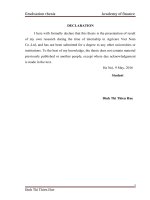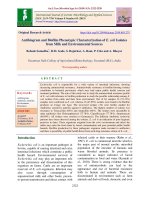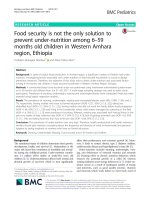Piglet diarrhea and technology transfers to prevent e coli infection at small holder pig farms in binh dinh, vietnam
Bạn đang xem bản rút gọn của tài liệu. Xem và tải ngay bản đầy đủ của tài liệu tại đây (539.21 KB, 10 trang )
Journal of Agricultural Science and Technology B 4 (2014) 696-705
Earlier title: Journal of Agricultural Science and Technology, ISSN 1939-1250
doi: 10.17265/2161-6256/2014.08.008
D
DAVID PUBLISHING
Piglet Diarrhea and Technology Transfers to Prevent E.
coli Infection at Small-Holder Pig Farms in Binh Dinh,
Vietnam
Nguyen Quang Linh1, Hoang Nghia Duyet1, Tran Quang Vui2 and Du Thanh Hang2
1. Centre for Incubation and Technology Transfers, Hue University, Hue 50999, Vietnam
2. Faculty of Animal Husbandry and Veterinary Medicine, College of Agriculture and Forestry, Hue University, Hue 50999, Vietnam
Received: July 4, 2014 / Published: August 20, 2014.
Abstract: The study aims at finding alternative interventions for the prevention of E. coli infection in piglets so as to boost farmers’
benefits and improve environment in the area. Data were collected from one experimental group consisting of 210 small pig holder
farms and one control group of 70 farms. All of 280 litters and sows were analyzed and the techniques of early vaccination at 60-80 d
of pregnant (time 1) were applied and repeated after 10 d with E. coli vaccine to produce antibodies through milk. The percentage of
piglets with diarrhea caused by E. coli significantly decreased from 75.7% to 18.9%. Injection of E. coli vaccine for the pregnant
sows created antibodies for young piglets through colostrums. The treatment of E. coli cost 45,420 Vietnam Dong (VND) per litter in
the experimental group and that was 156,000 VND/litter in the control group. Use of betel-bokashi (bio-product as plant antibiotics
and Lactobacillus) to treat piglet diarrhea was proved safe and effective. Litter size and average weight at birth and weaning were
improved significantly (P < 0.05). The average weaned weight of piglets and sows were 11.2 kg and 118.6 kg in the experimental
group, compared to 9.4 kg and 89.9 kg in the control group, respectively. Piglets in the experimental group had good health, no
diarrhea and a shorter weaning time (2 d) and mating interval 2.22 days earlier than those in the control group. The average profit of
210 households was significantly higher in the experiment group: feed-cost was much lower than that in the control group.
Small-holder farms implementing the experiments of applying the techniques received more financial profit, which was 1,502,000
VND per year per sow, while those who did not apply the techniques gained only 223,000 VND per year per sow.
Key words: Piglets, sows, E. coli, infection, households, benefit.
1. Introduction
Pig husbandry by small-holder farms in Binh Dinh
reduced in recent years because of disease infections
and a low market price of pigs. According to
Department of Agriculture and Rural Development
(DARD) report in 2002, there were more than
750,000 pigs in the province. The survey results
showed different structures of pig herds in seven
different locations; the Duc district had 15,000 sows,
which was the biggest population. Binh Dinh’s sows
Correspondingauthor: Nguyen Quang Linh, associated
professor, research fields: nutrition, diseases and system for
pigs and aquaculture. E-mail:
occupied 23.33% of the total population, which was
higher than other province (12%). There were some
provinces, which had much lower population, only
5.2% and 4.7% in Thua Thien Hue and Phu Yen
provinces, respectively [1-3]. It is possible to
improve the quality of pig breeding in Binh Dinh.
However, pig farmers faced many difficulties:
diseases, low pork market prices and productivity. In
particular, the disease caused by E. coli was the most
common (75.7%) and caused significant economic
losses, while the capacity and knowledge of control
and prevention of E. coli infection were still so
limited. Famers used antibiotics for treatment at a
Piglet Diarrhea and Technology Transfers to Prevent E. coli Infection at Small-Holder Pig Farms in Binh 697
Dinh, Vietnam
low level of efficiency. The research aimed at
exploring the transfer of techniques for farmers to
control the disease in piglets. The technique limited
the risks and had a low production cost. The research
aimed at prevention of diarrhea for piglets, especially
caused by E. coli, simultaneously increasing pig
farms’ income. Besides, the research aimed at
applying the techniques to prevent E. coli infection
and mitigate risks, reduce manufacturing costs,
improve product safety, perfect hygiene of food and
increase incomes for farmers [4-7]. The research also
aimed at: (1) the assessment of E. coli infection and
illness in swine, farmers’ techniques and economic
factors related to inputs, hence improving techniques
for farmers to control E. coli; (2) reducing the rate of
pigs infected with E. coli from about 75% at present
to 25% (or about 30% compared to the control
group), reducing approximately 50% of the cost of
veterinary drugs (antibiotics types) and increasing
the profits of farmers of about 20%; (3) raising
awareness and skills of applying technical
procedures for control disease by E. coli among pig
farming community.
2. Materials and Methods
2.1 Research Sites and Materials
The experiment carried out at seven different
locations with 210 smallholder pig farms of Hoai An,
Hoai Nhon, Phu My, Phu Cat, Tuy Phuoc, An Nhon
town and city of Quy Nhon in Binh Dinh province.
Each location included 30 pig farms of which each
had at least one breeding sow which was
two-to-three-month pregnant to receive E. coli
vaccine.
Time and schedules of the study: seven months,
from September 12, 2012 to May 7, 2013.
The study aims at assessing the situation of the
suckling sows and young piglets and examining the
infection of diseases, prevention and treatment
capacity of farmers and perceptions of the local
veterinary officers about the disease.
2.2 Methods
We selected 201 households to build seven models
of sows and piglets currently free from E. coli
infection at different locations by applying technical
measures and new approaches: vaccinating pregnant
sows at 60-80 d (time 1) and repeating after 10 d (time
2) with E. coli vaccine to produce antibodies in sows’
milk; as for the sow, clicking fangs and as for
umbilical disinfected pigs and piglets, feeding
colostrum as soon as possible [1, 3, 7, 8]; nurturing
and caring sows and piglets in accordance with sow
feeding technique (especially feed boxes for young
piglets in the first two weeks, maintaining temperature
at 32-34 °C); iron injection for piglets at three days
old, with a dose of 1 mL/animal (Dextran Fe, 20%)
and E. coli vaccine for pigs at 13 days old; feeding
piglets at 7-10 d of age, nursing piglets and weaned
piglets at the intervals of: 12 times/d, 10 times/d, 8
times/d, 6 times/d, 4 times/d, and finally 2 times/d
over time; vaccination for salmonellosis for piglets at
21 days old and cholera at 30 days old [8-11].
3. Results and Discussion
3.1 The Survey Results, Assessing the Status of Pig
and E. coli Disease
Pig husbandry is a profession for farmers in Binh
Dinh and the farmers have good traditional production
experiences. They faced difficulties such as epidemic
diseases, low pork prices and farmers not keen on pigs.
However, the pig herd did not change and the total of
sows is still unchanged in Hoai Nhon, Phu My and An
Duc districts. The control of FMD (foot and mouth
disease), PRRS (blue ear disease) and quarantine at
slaughter-houses and local markets were strengthened,
limiting the outbreak of epidemics.
3.2 The Size and Structure of the Herd
Overall structure of the herd in seven communes
showed differences, and Table 1 shows the average
total pig in communes.
698 Piglet Diarrhea and Technology Transfers to Prevent E. coli Infection at Small-Holder Pig Farms in Binh
Dinh, Vietnam
Table 1
No.
1
2
3
4
5
6
7
Swine herd and breeding stocks at different locations.
Communes
An Duc
Hoai Duc
My Hiep
Cat Hanh
Phuoc Thang
Nhon Hoa
Nhon Binh
Mean
Total of pigs
15,000
13,800
8,250
5,200
7,543
2,250
2,355
7,771
Total of sows
4,000
1,560
3,150
1,400
1,600
820
164
1,813
% F1 sows
82
85
43.3
81.3
82
95
80
78.4
% F2 sows
18
15
36.7
15.6
18
5
12
17.2
% MC sows
0
0
20
3.1
0
0
8
4.4
F1, F2: crossbreds of LW & LD, Yorkshire; MC: local breed.
Table 2
Different swine breeds and reproductive performance.
Breeds No.
F1
F2
MC
Litter index
M ± SD
1,012 2.00 ± 0.27
771
2.00 ± 0.21
30
2.00 ± 0.15
Litter size
at birth
M ± SD
11.02a ± 1.21
10.33b ± 1.15
12.00c ± 1.41
Litter size at weaning
M ± SD
8.57 ± 0.71
7.90 ± 0.92
9.00 ± 0.98
Weaning weight
(kg)
M ± SD
9.10a ± 1.21
10.33b ± 1.15
10.00b ± 1.32
Weaning age
(d)
M ± SD
42.40a ± 7.25
36.67b ± 8.72
50.00c ± 9.21
Come in heat
(d)
M ± SD
8.33 ± 2.0
11.33 ± 2.11
7.00 ± 1.21
a ≠ b ≠ c in the same column, with P ≤ 0.05.
High quality sows are shown by the indicators of
the reproductive performance in Table 2 which shows
that sows have a high fertility, suggesting that people
know how to choose breeding sows, although origin
sows is unclear, birth rates and reproductive
performance are relatively high.
Litter index and litter size are stable from two to
eight, and the litter size at weaning was 75% and
weight was only 9.35 kg/head with suckling time up
to 42-50 d. Table 2 shows that the number of piglets
of MC (local breed) alive at birth and weaning were
the highest compared with F1 and F2 crossbreds, and
weight of weaning piglets in F2 was higher than other
breeds.
3.3 Swine Housing Systems
In interviews with the residents and farmers, it was
found that housing systems were traditionally built
which did not have farrowing pens for suckling
piglets and sows. The farmers do not fully
understand the important role of housing and
adequate investment. The housing system was
mainly simple pens, with insufficient spaces, poor
ventilation system, no bars and creep feed boxes.
There was no separation between lying and feces
areas. Table 3 shows that most housing pens are
separated from kitchen which attached to the house
(93.6%), which was necessary to be improved for the
safety of pigs and humans. Most pig housing did not
follow any set designs, types and techniques; there
was just only one type K45 of Vietnam standard,
where they changed the roof and bars, which caused
humid and hot and had a good ventilation system for
swine, pig farms in Nhon Hoa, Nhon Binh and Phuoc
Thang lack of spaces for sows and piglets though.
Most sheds, built of brick or concrete, there were
32.1% fibro roofs and 52.1% other materials,
however, did not have a roof barn and two-level
ventilation system to avoid the toxic exhaust. The
farmers were interested in building a biogas system
indicating several advantages, such as improvement
of their quality of life in rural areas, living
environment protection and cheap fuel source. The
farmers would like to have a housing system for pigs,
but they did not want to invest more because they
only wanted to have direct benefits from pigs.
Piglet Diarrhea and Technology Transfers to Prevent E. coli Infection at Small-Holder Pig Farms in Binh 699
Dinh, Vietnam
Table 3
Pig housing in different communes (%).
No.
Communes
1
2
3
4
5
6
7
An Duc
Hoai Duc
My Hiep
Cat Hanh
Phuoc Thang
Nhon Hoa
Nhon Binh
Mean
Separated from
kitchen
97
93
97
90
85
96
97
93.6
One row
Two rows
Cement and iron
Brick roof
Fibro
Corrugated iron
85
60
80
85
75
77
77
77.0
15
40
20
15
25
23
23
23.0
100
100
100
100
100
100
100
100
35
56.6
57
37
39
70
70
52.1
45
30
27
37
40
23
23
32.1
20
13.4
16
26
21
7
ND
15.8
ND: not determined.
Table 4
Feedstuffs and feeding systems.
No.
Communes
1
2
3
4
5
6
7
An Duc
Hoai Duc
My Hiep
Cat Hanh
Phuoc Thang
Nhon Hoa
Nhon Binh
Mean
Pregnant period
Mixed on-farm (%)
Commercial feed (%)
68
32
70
30
80
20
69.7
30.3
65
35
57
43
80
20
70
30
Mixed (%)
65
50
67
41.8
45
55
50
53.4
Suckling period
Commercial feed (%)
35
50
33
58.2
55
45
50
46.0
3.4 Feedstuffs and Feedings
disease.
A total of 70% of feeds prepared on-farms and 30%
commercial feeds can be easily spotted in Table 4.
Commercial feeds had a higher ration in stage of
pregnancy and young piglets, up to 53.4%, so the
different feed was applied in different growth stages
of sows and growing piglets. Bigger scale pig farms
had more advantages regarding feedstuffs prepared
on-farm, and they could make more profit as said by
Mrs. Le Thi Minh in Hoai Nhon. Small holder pig
farms using leftover food from restaurants also
increased profits significantly; however they had to
cook again for disinfection before feeding to pigs.
In terms of pig feeds alternatives, many households
usually use different local feedstuffs, mix them at the
farms and add commercial feed to it; this alternative
can reduce the feed-cost and thus increase benefit. The
pig dietary composition has more problems due to
unbalance of nutrient composition to ensure the fast
growing, best meat quality and increase resistance to
3.5 Disease Infections and Situation
Infection of E. coli to sows and piglets is very
common, on average up to 75.7% for pig farms in
Binh Dinh province, there is considerable of economic
losses according to the Department of Agriculture and
Rural Development and World Bank/ACP project.
Diarrhea causes not only economic losses but also
environment pollution, and unsafe human food. Table
5 shows that the epidemic situation was very common
in pig farming households, with many different
reasons: (1) humid on floor; (2) pigs eating
contaminated food; (3) low resistance; (4) pigs can be
infected due to prolonged cold without creep
boxes/cages or nursery warm pads, and iron
deficiency in the blood at the age of 7-13 days old. In
addition, sows infected by E. coli reduce resistance of
the fetus to diseases and cause fetal death and birth
asphyxia.
700 Piglet Diarrhea and Technology Transfers to Prevent E. coli Infection at Small-Holder Pig Farms in Binh
Dinh, Vietnam
Table 5
E. coli vaccinated to sows and infection in young piglets.
No.
Communes
1
2
3
4
5
6
7
An Duc
Hoai Duc
My Hiep
Cat Hanh
Phuoc Thang
Nhon Hoa
Nhon Binh
Mean
Table 6
Pregnant
sows (%)
10
8
8.5
6.6
7.5
6.5
7.0
7.7
Birth
piglets/litter
11.2
10.75
10.4
10.1
10.5
10.1
10.2
10.46
Infected
litters (%)
75
80
75
65
70
85
80
75.7
Weaning
piglets (n)
9.8
8.8
7.9
9.4
9.6
8.1
8.3
8.84
Weaning
piglets (%)
87.5
81.9
76.0
93.1
91.4
80.2
81.4
84.5
Weaning
weight (kg)
9.0
7.8
8.3
9.4
9.8
9.6
10.7
9.2
Weaning days
(d)
42.3
42.0
45.0
44.8
41.5
45.0
44.5
43.6
Disease infection in pig householder farms (litters).
Diarrhea
Suckling pigs
Weaning piglets
Infected
158
141
No.
52
69
Treatment (d) ND
ND
E. coli vaccines,
Medicine
Anti-biotics
antibiotic
Overcome (d) 45
131
Diseases
Birth diarrhea
Suckling pigs
112
ND
6-8
Respiration
Suckling pigs Weaning piglets
55
21
ND
ND
5
7
Others
Suckling pigs Weaning piglets
35
42
ND
ND
5
ND
E. coli vaccine Anti-biotics
Anti-biotics
Anti-biotics
Anti-biotics
17
11
52
ND
55
ND: not determined.
Building an epidemiology model of diarrhea
disease at commune level is very common and many
local people are interested in pig husbandry and how
to increase piglets’ resistance to diseases in the local
environment and conditions. There were many
comments from farmers and exchange of opinion in
the first workshop on diseases, problems and remedies.
Farmers should also be aware that sows should get
vaccine soon to enhance resistance of piglets to
disease through breast milk in their first weeks
(colostrum). The farmers were still confused and
suspicious of the effectiveness of vaccination to the
fetus in gestation period, which they thought would be
dangerous, and very risky. Therefore, the local
program experts and scientists advised for farmers to
use the techniques and different time periods for
different technical model, based on scientific and
preventive measures for pigs by comprehensive
techniques and minimizing risks. E. coli are common
in breeding sows and young piglets in Binh Dinh.
Through evaluation of the possibility of the disease
prevention and treatment in seven models in Binh
Dinh province, the result showed the disease situation
and the need for interventions. The observation on 210
small-holder pig farms suggested only 7%-10% to
have vaccination during pregnancy and to apply
simple methods in some locations such as Phuoc
Thang, and Hoai Nhon commune. The farmers did not
apply the techniques and they were afraid of the risk
by vaccination for new born piglets. The results of
investigation and assessment of the situation of
disease in Nhon Binh showed that sows were often
infected with respiratory diseases and PRRS and have
fetal death phenomenon in biological processes, and
this is an issue to be studied in the pregnancy period.
There was more piglets’ period stillborn. This is also
the problem of the swine industry in Binh Dinh in
particular and in the country in general. The
difficulties in overcoming diseases and market prices
are still the big questions for all levels and sectors,
both the state and the farmers.
Thus, Table 6 showed that the sow herd was mainly
infected with infectious disease or suffered from
respiratory. The ratio of piglets having diarrhea were
up to 75.10%. The farmers applied many ways to treat
piglet diarrhea. They used injection of vaccines
Piglet Diarrhea and Technology Transfers to Prevent E. coli Infection at Small-Holder Pig Farms in Binh 701
Dinh, Vietnam
directly into young piglets or used antibiotic. There
was a high rate of infection, up to 95%. The total
number of piglets having diarrhea, using antibodies
was said to be about 30%. They said that using
antibodies were so expensive [6], leading to a high
cost of rising weaned piglets. Farmers had discussed
the conditions of housing, feeding systems and health
care, and there were more problems in pig husbandry:
(1) due to limited housing spaces and being lack of
major facilities and farming equipment, and changes
of the weather, piglet diarrhea occur; (2) most people
recommended an integrated methodical, proactive,
and practical management of piglets and sows; (3) a
monotonous diet of pigs, nutritional imbalance, feed
creep depending on unstable capital was one of the
causes of digestive disorders and birth diarrhea.
A high proportion of piglets were infected with
diarrhea caused by E. coli, and technical applications
were necessary for farmers. The instructions were
delivered in a training course for farmers with the help
from farmer associations at the local level. Farmers
acquired the pig farming processes through “learning
Table 7
E. coli infected in control and experiments.
Locations
Infected rate (%)
An Duc
20.1 ± 2.71
Hoai Duc
19.3 ± 2.85
My Hiep
21.4 ± 4.43
Cat Hanh
20.7 ± 2.86
Phuoc Thang 13.5 ± 2.56
Nhon Hoa
14.4 ± 3.34
Nhon Binh
23.8 ± 3.02
M ± SE
19.2 ± 2.63
Table 8
by doing”. Regular consulting, monitoring and
recording progress of the participating farmers have a
good progress for pig husbandry. The results in Table
7 showed the percentage of piglets with diarrhea
between the two groups of sows in different models. It
was interesting to see that percentage of sows
infected with diarrhea among the vaccinated groups
(in experiment) decreased from 75.7% to 13.5%, and
the number of piglets at birth suffering from diarrhea,
caused by E. coli significantly reduced, which proved
effectiveness in preventing diarrhea. If pigs are born,
there will be high possibility that young piglets will
respond well to medication and soon recover during
the nursing period, which significantly reduced costs of
treatment. Health care and feeding were improved. In
addition, with the intention of vaccination for pregnant
sows and young piglets to have earlier antibodies for
prevention of diseases, efficiency of E. coli
vaccination for sows and piglets could be clearly seen
in 20%-25% of the vaccinated pigs which was so close
as basic control piglets with diarrhea in breastfeeding
period. Tables 8 and 9 showed the outcome of the
Experimental group
Level
Treatment time (d)
Normal
2-4
Normal
2-4
Normal
2-4
Normal
2-3
Normal
2-3
Normal
2-3
Normal
2-4
Normal
2-3
Infected rate (%)
69.2 ± 2.11
75.0 ± 2.03
81.2 ± 2.02
74.9 ± 1.79
65.2 ± 2.87
70.3 ± 1.91
85.2 ± 1.78
80.0 ± 1.81
Control group
Level
Serious
Serious
Serious
Serious
Serious
Serious
Serious
Serious
Treatment time (d)
5-7
5-7
6-7
5-6
5-6
5-7
5-7
5-7
Costs for treatment/litter.
Communes
An Duc
Hoai Duc
My Hiep
Cat Hanh
Phuoc Thang
Nhon Hoa
Nhon Binh
Mean
Infected (%)
19.3
21.4
20.7
13.5
14.4
23.8
19.2
18.9
Experiments (VND/litter)
Costs
VND
60,000
11,580
60,000
12,840
60,000
12,420
60,000
8,100
60,000
8,640
60,000
14,280
60,000
11,520
60,000
11,340
Infected (%)
75
80
75
65
70
85
80
75.7
Control (VND/litter)
Costs
VND
60,000
45,000
60,000
48,000
60,000
45,000
60,000
39,000
60,000
42,000
60,000
51,000
60,000
48,000
60,000
45,420
702 Piglet Diarrhea and Technology Transfers to Prevent E. coli Infection at Small-Holder Pig Farms in Binh
Dinh, Vietnam
Table 9
Reproductive performance.
Communes
An Duc
Hoai Duc
My Hiep
Cat Hanh
P. Thang
Nhon Hoa
Nhon Binh
M ± SD
Experiment
Litter size at
Litter size at birth
weaning
12.83a ± 0.19
12.56a ± 0.17
a
11.79 ± 0.37
11.00a ± 0.23
a
11.03 ± 0.23
10.34a ± 0.18
11.57a ± 0.37
10.9 ± 0.24
10.2a ± 0.23
9.96 ± 0.27
10.03a ± 0.27
9.83a ± 0.22
a
10.67 ± 0.27
10.43a ± 0.26
a
11.14 ± 0.27
10.71a ± 0.35
Control
Litter size at
Weaning rate (%) Litter size at birth
weaning
98.1 ± 0.88
11.2b ± 0.22
9.8b ± 0.19
b
94.3 ± 1.78
10.8 ± 0.15
8.8b ± 0.11
b
94.17 ± 1.21
10.4 ± 0.16
8.2b ± 0.15
95.16 ± 1.28
10.1b ± 0.21
9.4b ± 0.20
97.4 ± 0.86
10.5 ± 0.16
9.6b ± 0.13
98.36 ± 0.71
10.1 ± 0.26
8.2b ± 0.19
97.63 ± 0.91
10.2 ± 0.21
8.3b ± 0.13
a
b
96.5 ± 1.42
10.47 ± 0.28
8.91b ± 0.27
Weaning rate (%)
87.9 ± 1.58
82.4 ± 1.07
78.9 ± 1.17
92.9 ± 1.19
91.4 ± 0.95
80.2 ± 1.21
81.4 ± 1.17
85.3b ± 1.57
a ≠ b in the same row, with P ≤ 0.05.
techniques have significant results for pig husbandry.
The health of sows and piglets was improved, which
showed that applying the integrated methods for pig
husbandry had a good result. The experiment group
had less disease incidences only 18.9%, compared
with 75.9% of the control group.
3.6 Reduction of the Treatment Costs
Based on sow feeding diary and daily monitoring
cards, farmers reported that cost of medicines and
treatment were lower and the number of piglets in the
experiment group recovered, when they used
betel-bokashi (bio-product as plant antibiotics and
Lactobacillus) was higher. The technique was so
effective that piglets recovered quickly after treatment.
Table 8 showed that the results of interventions
towards diarrhea caused by E. coli were different, and
the cost of treatment was lower when famers used
creep boxes for piglets and vaccine for pregnant sows,
just only 45,420 VND per litter, compared to 156,000
VND per litter in the control group in small-holder pig
farms. On the other hand, there were not only
economic losses, but also pollution of environment
and more importantly, using common antibiotics will
influence human health and products.
3.7 Reproductive Performance
The results in Table 9 showed that the reproductive
performance of sows was markedly enhanced in the
households in the experiment group than that in the
control group. Weaning rate was much higher in the
experiment group than that in the control group.
Hence applying integrated techniques to raise sows
and piglets, famers had more opportunities to get a
higher litter size at birth and weaning. Table 9 showed
that, litter size at weaning of the experiment group
was 10.71 piglets, approximately 20% higher than that
of the control group, 8.74 piglets. Weaners had a
better quality (healthier and faster growing).
Reproductive performance of sows in Tables 9 and
10 were higher in the experiment than that in the
control group, indicating that applying integrated
techniques for raising sow and piglets were necessary
for farmers and local communities. Besides increasing
productivity, integrated techniques also helped local
communities take care of not only pigs’ health but
also human’ health as well, and improve environment
due to less antibiotics and chemicals used. However,
the farmers have to pay attention to the following
point. Results showed that piglets grew faster in the
experiment group than that in the control group in all
communes applying the techniques. The reason was
that farmers in traditional techniques waited too long
to feed piglets with food while kept a long suckling
period. Early weaning happened when farmers wanted
to sell small piglets for pig roast market and exported
to Laos or Taiwan. Therefore, sows had problems due
to sudden weaning and had a longer time to get ready
to be bred again after weaning. Therefore, farmers
must have a proper plan for piglet sale, sow health
Piglet Diarrhea and Technology Transfers to Prevent E. coli Infection at Small-Holder Pig Farms in Binh 703
Dinh, Vietnam
Table 10
Weight of weaning piglets.
Communes
An Duc
Hoai Duc
My Hiep
Cat Hanh
Phuoc Thang
Nhon Hoa
Nhon Binh
M ± SD
Table 11
Weaning
weight/piglet
9.2 ± 0.17
11.2 ± 0.21
10.2 ± 0.20
11.7 ± 0.12
12.1 ± 0.27
12.2 ± 0.16
11.8 ± 0.16
11.2 ± 0.20
Experiments
Weaning
weight/litter
115.9 ± 2.27
122.1 ± 2.22
105.1 ± 2.01
126.8 ± 2.46
119.5 ± 2.58
118.9 ± 1.80
122.0 ± 2.39
118.6 ± 1.95
Wea. period (d)
36.9 ± 0.67
40.5 ± 0.65
38.7 ± 0.87
45.3 ± 0.77
41.6 ± 0.74
44.5 ± 0.44
44.3 ± 0.32
41.7 ± 0.72
Weaning
weight/pig
9.0 ± 0.25
8.2 ± 0.23
8.6 ± 0.28
9.4 ± 0.31
9.8 ± 0.29
9.8 ± 0.35
10.7 ± 0.25
9.4 ± 0.32
Control
Weaning
weight/litter
88.2 ± 2.92
72.6 ± 2.26
89.7 ± 3.45
88.4 ± 3.68
102.4 ± 0.33
99.3 ± 4.27
88.8 ± 2.41
89.9 ± 2.34
42.3 ± 1.40
42.5 ± 1.45
45.1 ± 1.11
44.8 ± 1.21
41.5 ± 0.93
45.0 ± 1.45
44.5 ± 0.75
43.7 ± 1.46
Control
FCR (kg)
5.65 ± 0.18
6.17 ± 0.12
5.22 ± 0.15
5.42 ± 0.19
4.57 ± 0.09
4.92 ± 0.21
4.19 ± 0.06
5.17 ± 0.17
Benefits/litter
166.9 ± 87.8
-169.3 ± 48.2
235.2 ± 72.1
128.6 ± 105.7
619.8 ± 56.9
427.9 ± 83.9
178.0 ± 46.7
223.3 ± 62.1
Wea. period (d)
Litters/sow/year, Feed conversion rate and benefits (1,000 VND).
Locations
An Duc
Hoai Duc
My Hiep
Cat Hanh
Phuoc Thang
Nhon Hoa
Nhon Binh
M ± SD
Litter index (n)
2.28 ± 0.01
2.24 ± 0.01
2.29 ± 0.03
2.16 ± 0.01
2.22 ± 0.01
2.18 ± 0.01
2.19 ± 0.01
2.22 ± 0.02
Experiments
FCR (kg)
3.56 ± 0.13
3.59 ± 0.05
4.02 ± 0.05
3.77 ± 0.04
3.75 ± 0.07
3.84 ± 0.03
3.76 ± 0.04
3.75 ± 0.11
Benefits/litter
1,545 ± 54.3
1,708 ± 58.9
1,197 ± 37.6
1,516 ± 47.5
1,570 ± 80.2
1,422 ± 36.7
1,519 ± 60.3
1,502 ± 63.0
care and mating timing, otherwise, sows will be
negatively affected by the early weaning. Phuoc
Thang, An Hiep Duc sows had clinical signs of
mastitis. After sudden sales of piglets, farmers should
have massaged those sows’ teats daily.
3.8 Profit Applying Model
Table 11 showed different profit from the sow
reproduction between small-holder pig farms in Binh
Dinh. The farmers applying the techniques had higher
income than other farms, which can be a sign for local
communities to pay attention to technological role. In
the final seminars at each commune, farmers said that
the integrated techniques brought a better benefit and
a good environment for their locations but it was not
easy to implement daily. Table 11 indicated that less
feed and medicine costs for sows and piglets, a higher
income and benefit for farms of 210 small-holder pig
farms which was due to a reduction of feed-cost from
5.17 kg of the control group to 3.18 kg of experiment
group.
Litter index (n)
2.12 ± 0.02
2.08 ± 0.02
2.09 ± 0.01
2.07 ± 0.02
2.11 ± 0.02
2.10 ± 0.02
2.11 ± 0.01
2.10 ± 0.16
It demonstrated effective application of technical
procedures brought about economic efficiency.
Although prices of pig breeds in the market were so
low at that time compared to the previous year but
farmers of the experiment group were so happy with
more benefit, gained 1,502,000 VND/sow/year,
compared with 223,300 VND/sow/year of the control
group.
Results of the experiment on integrated technical
application in pig production in Binh Dinh indicated
more impetus for local farmers to apply the techniques
and pay attention to technology. However, they
always have to have a sustainable policy. We are also
providing more consultancy for local authorizes and
local leaders, so that they can maintain their
communities’ awareness and motivations. Since,
farmers can join pig production clubs and farmer
associations. Scientists go to field trips, and transfer
technology under method of “learning by doing”
teaching philosophy and exchange practical
experience on sow performance; we organized seven
704 Piglet Diarrhea and Technology Transfers to Prevent E. coli Infection at Small-Holder Pig Farms in Binh
Dinh, Vietnam
farmers to farmers (FoF) seminars and workshops to
share experiences on sow reproduction. In all of the
meetings and seminars at farm levels, farmers showed
their interests in learning by doing; the number of
participants attending the final workshop was more
than the first workshops. It was necessary to have
demonstration sites, which can be soon applied for
farmers in Binh Dinh. Scientists must pay more field
trips to motivate farmers. Furthermore, local
authorities and companies should cooperate with
farmers and scientists. Many enthusiastic comments
from farmers were noted, and they said that new
technology was easy to acquire through learning by
doing at community level. A farmer in Cat Hanh said
that “I don’t understand the theory much but I know
how to do well on field leading me to more successful
and effective farming”.
4. Conclusions
Sows and piglets at small-holder pig farms in Binh
Dinh had problems of E. coli infection for the
following reasons: (1) a high humidity; (2)
contaminated feed by feeding systems; (3) poor
resistance; (4) lack of creep boxes, a low Fe2+ in the
blood (at period of 7-13 d). In addition to the above
causes, pathogens were transmitted from pigs to pigs
and from areas to areas, low resistance of the fetus,
pregnancy problems and poor health care and
management.
The percentage of piglets with diarrhea caused by E.
coli significantly decreased from 75.7% to 18.9%
since applying E. coli vaccination for pregnant sows
and Dextran-Fe given by injection for young piglets
leading to reduction of the cost of treatment of E. coli
infection. There was only 25% of treatment of costs,
compared to the control group. The using of
Betel-Bokashi was illustrated more effectiveness and
safety.
Results showed a significant improvement of
reproductive performance for sows by increasing litter
size at birth and weaning and reduction of piglet
deaths at birth (11.2 kg/piglet and 118.6 kg/litter,
compared to 9.4 kg/piglet and 89.9 kg/litter),
simultaneously, the results also was earlier weaning of
2.22 days.
The transfer of techniques of earlier E. coli
vaccination, and use of betel-bokashi for treatment
and creep boxes increased farmer’s income. These
also increased awareness and knowledge not only of
farmers, but also local vets, authorities and leaders
about the disease and E. coli infection. Making
changes of pig farming practices and their capacity to
apply science and technology for prevention was not
easy. Reducing the use of antibiotics will enhance the
bio-security in smallholder pig farms and limit
environmental pollution in rural areas.
Acknowledgments
The authors gratefully acknowledge ACP/WB Binh
Dinh for providing finance for the studies, local
farmers and veterinary offices for their cooperation,
colleagues of Binh Dinh, Mr. Dinh Van Nho, Miss
Kieu Thi Huyen and Miss Nguyen Thi Tra My for
their inputs and responsibilities.
References
[1]
[2]
[3]
[4]
[5]
Thuy, D. N., Phu, C. H., and Trott, D. 2009. “Oedema in
Piglets and Prevention Techniques.” Presented at the
Proceedings in AAAP Conference, Hanoi.
Nguyen, N. N., Cu, H. P., and Phan, T. H. 2001. “Features
and Infected Factors of E. coli to Oedema in Piglets of
Binh Dinh Province.” Vietnam Journal of Agriculture and
Rural Development 11: 804-5.
Ho, P. T., Phu, C. H., and Thuy, D. N. 2003. “Isolation,
Determination of Biochemical Characterizes of E. coli
Caused Oedema on Piglets in Binh Dinh, Techniques for
Prevention and Treatment.” In Proceedings of the
National Conference in South Central Vietnam, 250-6.
Phu, C. H., Ho, P. T., Huong, V. T., and Thuy, D. N. 2006.
“Compared the Antibody Tiers in after Vaccinated of E.
coli for Oedema in Piglets.” Vietnam Journal of
Agriculture and Rural Development 10: 57-62.
Linh, N. Q., Duyet, H. N., Hai, V. V., Hue, H. T., Toan, N.
H., Trott, D. J., Fahy, V. A., and Cargill, C. 2009.
“Influence of Different Breeds, Feeding and Housing
Systems on Sow Reproductive Performance in Central
Vietnam.” Presented at the AAAP Conference in Hanoi.
Piglet Diarrhea and Technology Transfers to Prevent E. coli Infection at Small-Holder Pig Farms in Binh 705
Dinh, Vietnam
[6]
[7]
[8]
[9]
Linh, Q. N., Bao, N. H., Phuong, H. N., Trott, D. J., Fahy,
V. A., and Cargill, C. 2009. “Influence of Different
Housing Systems Approach to Sow Reproductive
Performance and Growth of Suckling Piglets in Thua
Thien Hue.” Presented at the AAAP Conference in Hanoi.
Martens, M., and Valks, M. 1999. “Porcills Coli: Still the
Most Potent Vaccine against E. coli Enterotoxicosis.”
Intervet VSD Newltter 18: 1-6.
Morgan, R. L., Isaacson, R. E., Moon, H. W., Brinton, C.
C., and To, C. C. 1978. “Immunization of Suckling Pigs
against Enterotoxigenic Escherichia coli Induced
Diarrheal Disease by Vaccinating Dams with Purified 987
or K99 Pili: Protection Correlates with Pilus Homology
of Vaccine and Challenge.” Infect. Immun. 771-7.
Thuy, D. N., Trott, D. J., Linh, N. Q., Duyet, H. N., and
View publication stats
Phu, C. H. 2010. “Influence of Different Housing
Systems and Feeding Regime on E. coli Problems of
Post-Weaning Piglets in Central Vietnam.” In
Proceedings of the 21st IPVS Congress, 765.
[10] Do, N. T., Cu, H. P., and Darren, T. 2006. “Comparative
Resistance Profiles of Enterotoxigenic Escherichia coli
Isolated from Australia and Vietnam.” In Proceedings of
the 19th IPVS Congress, 462.
[11] Hoang, N. D., Nguyen, Q. L., Cargill, C., and Trott, D.
2010. “Influence of E. coli Vaccine for Pregnant Sows to
Diarrhea of Piglets in Central Vietnam.” In Proceedings
of the 14th Animal Science Congress of the
Asian-Australasian Association of Animal Production
Societies, 460.



